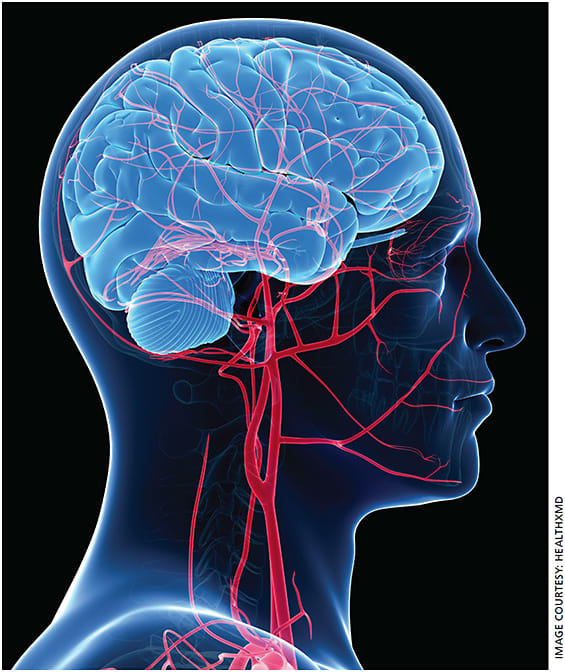Device can also detect certain medical conditions.
An eye-care visit can be a prime opportunity to expand a patient’s level of care beyond vision services. “Eye-care providers are in a unique position to diagnose vascular diseases of the eye,” says James L. Johnston, Jr., DO, a neuro-ophthalmologist at Novus Clinic in Tallmadge, Ohio, who offers HealthxMD’s transcranial Doppler (TCD) testing at his practice. “If such diseases are found, this obligates us to continue searching for any associated vascular diseases of the brain. Ophthalmology offices have numerous technologies for examining the eye, but very few can determine the health of the brain’s vasculature. By incorporating HealthxMD’s services into our clinic, we can provide on-site TCD testing for patients at high risk for intracranial vascular disease.”

Because his practice has patients with multiple vasculopathic comorbidities such as diabetes and hypertension, putting them at high risk for stroke and deep vein thrombosis, Blake K. Williamson, MD, MPH, MS, at Williamson Eye in Baton Rouge, La., decided to offer HealthxMD testing services. “Our practice does general care in addition to eye care; we provide an overall health check such as testing patients’ blood pressure and blood sugar,” says the refractive, cataract and anterior segment surgeon. “For patients with certain criteria, we recommend TCD testing.”
HOW IT WORKS
TCD is a safe, low-frequency pulsed Doppler ultrasound technology that measures blood flow velocity and direction within the Circle of Willis, vertebrobasilar system, carotid siphon and ophthalmic arteries.
The non-invasive approach uses each of the six cranial windows naturally occurring in cranial anatomy (ie, temporal, orbital and sub-occipital). The technical aspects of waveform interpretation involve changes in velocity, systolic upstroke, flow direction, laterality and pulsatility.
In addition, hypercapnic challenge with a breath-holding technique is used as a physiologic test to measure vaso-motor reserve. Lastly, microembolism detection is performed without microbubble injection. For ophthalmologic purposes, Dr. Johnston says TCD is most applicable at detecting intracranial stenosis, carotid artery stenosis, microembolisms and normal tension/primary open-angle glaucoma.
HealthxMD’s diagnostic test can also identify patients who may be at risk of stroke or other cardiovascular events. Additionally, it can be an early stage diagnostic for patients with potential glaucoma. HealthxMD reviews the criteria that could warrant a TCD to be ordered with each physician, based upon their medical knowledge and patient demographic, then creates a standard of care within each clinic. This ensures that only patients who meet medical necessity are tested, says Ron Greenberg, president of HealthxMD in Sarasota, Fla.
Some conditions that could warrant a test to be ordered include type 1 or 2 diabetes, diabetic retinopathy, hypertensive retinopathy, glaucoma (ie, primary open-angle glaucoma, low tension, chronic open-angle, glaucoma suspect), branch vs central retinal vein and artery occlusion, retinal ischemia and retinal neovascularization. A HealthxMD staff member pre-screens patient charts and identifies candidates from doctors’ ordering criteria.
HealthxMD employs certified ultrasound technicians, trained in TCD testing, who are then placed within practices. The technician performs TCD diagnostic testing on patients who meet the ordering physician’s criteria.
Dr. Johnston praises how seamlessly HealthxMD was integrated into his practice. “The testing equipment, technicians, staff training and radiologists were all provided with no upfront cost of implementation. The training team was available and on-site, and they were eager to assist with the initial startup while maintaining good communication.”
Practice staff are trained to ensure that TCD testing is integrated into the patient flow. The practice receives regular e-mail alerts of any critical findings that radiologists report.
EASE OF USE
HealthxMD’s onboarding protocol ensures a streamlined approach once it’s live within a practice, Mr. Greenberg says. The process includes education and operational guidelines established in collaboration with physician groups, clinical businesses and operations staff within each practice.
Testing typically takes no longer than 20 minutes. The practice also contracts with an independent teleradiology company to interpret the TCD. Data is sent through a secure system to the teleradiology service, which provides test results in 2 to 3 days (unless an urgent 24-hour read is requested). Ordering physicians review radiology reports, then patients are either contacted by phone or letter in the case of negative test results, Dr. Johnston says. For positive results, the ordering physician may order follow-up testing and care either within the ophthalmology office, in the case of eye disease, or within the medical community, in the case of brain disease.
Ergonomically, the TCD unit is lightweight and easily transportable from office to office.
IMPROVING PATIENT OUTCOMES
In a retrospective chart review, Dr. Johnston’s practice found that 43% of 468 patients tested with HealthxMD had positive test results. Of those positive results, 5.5% of patients had some form of glaucoma, most commonly normal tension glaucoma, which required further diagnostic testing and treatment with topical therapy. Also, 17% of positive cases demonstrated neurologic disease, which required further diagnostic testing and treatment.
By incorporating TCD into Dr. Johnston’s clinical practice, physicians are now better able to diagnose and promptly treat insidious eye and brain diseases that may have otherwise gone unnoticed.
In particular, Dr. Johnston has found TCD to be helpful in diagnosing glaucoma, especially normal tension glaucoma in which the examining physician doesn’t have the benefit of observing an elevated IOP and may not have any clear visual evidence of early optic nerve head damage.
Dr. Williamson views the diagnostic test as an opportunity to get patients thinking about their overall cardiovascular health.
“I identified six patients with emboli on blood vessels on the brain. I potentially helped save their lives,” he says. “TCD is a good service to offer to the community.” OM








